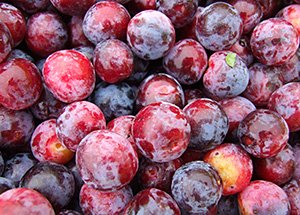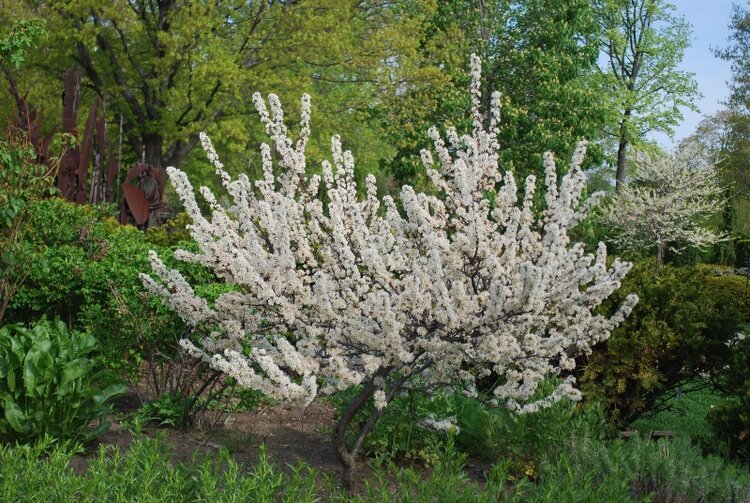Beach Plum
Growing up in New England always meant summer trips to the many beaches on the East Coast of America. A trip to any old cottage country store would surely have jars of the famously delicious Beach Plum jam! Native to the sandy dunes in the region, Beach Plums have a romantic appeal as one of the first fruits the early settlers would have encountered and eaten in the New World. Native Americans were already very well acquainted with Beach Plums and used them in their staple food, Pemmican. Though once very abundant, this drought and salt tolerant shrub has become tougher to forage since many coastlines have been developed. It is certainly still around, though don’t try asking a local for their favorite patch….a hardy New Englander keeps that type of secret close to the heart! Luckily they are easy to grow in a yard or orchard setting. They will tolerate poor soil, but do great in rich soil and full sun. They put on a beautiful flower show in spring and in some years set a massive bumper crops that will stock your pantry with that famous jam! Not self pollinating so at least two are needed for fruit set.
Zones 3-8
Ships as a dormant bare-root plant
Growing up in New England always meant summer trips to the many beaches on the East Coast of America. A trip to any old cottage country store would surely have jars of the famously delicious Beach Plum jam! Native to the sandy dunes in the region, Beach Plums have a romantic appeal as one of the first fruits the early settlers would have encountered and eaten in the New World. Native Americans were already very well acquainted with Beach Plums and used them in their staple food, Pemmican. Though once very abundant, this drought and salt tolerant shrub has become tougher to forage since many coastlines have been developed. It is certainly still around, though don’t try asking a local for their favorite patch….a hardy New Englander keeps that type of secret close to the heart! Luckily they are easy to grow in a yard or orchard setting. They will tolerate poor soil, but do great in rich soil and full sun. They put on a beautiful flower show in spring and in some years set a massive bumper crops that will stock your pantry with that famous jam! Not self pollinating so at least two are needed for fruit set.
Zones 3-8
Ships as a dormant bare-root plant
Growing up in New England always meant summer trips to the many beaches on the East Coast of America. A trip to any old cottage country store would surely have jars of the famously delicious Beach Plum jam! Native to the sandy dunes in the region, Beach Plums have a romantic appeal as one of the first fruits the early settlers would have encountered and eaten in the New World. Native Americans were already very well acquainted with Beach Plums and used them in their staple food, Pemmican. Though once very abundant, this drought and salt tolerant shrub has become tougher to forage since many coastlines have been developed. It is certainly still around, though don’t try asking a local for their favorite patch….a hardy New Englander keeps that type of secret close to the heart! Luckily they are easy to grow in a yard or orchard setting. They will tolerate poor soil, but do great in rich soil and full sun. They put on a beautiful flower show in spring and in some years set a massive bumper crops that will stock your pantry with that famous jam! Not self pollinating so at least two are needed for fruit set.
Zones 3-8
Ships as a dormant bare-root plant


